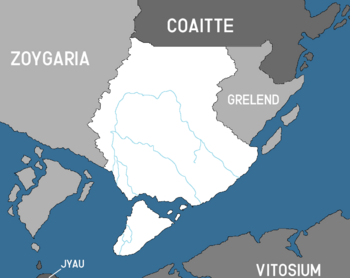Riovenia: Difference between revisions
Driftsauro (talk | contribs) No edit summary |
Driftsauro (talk | contribs) No edit summary |
||
| Line 63: | Line 63: | ||
Riovenia, officially the '''Unitary Republic of Riovenia''', is a country in southeast [[Nortua]], consisting of a continental landmass and many islands in the Strait of Grelend. Riovenia is bordered by [[Zoygaria]] to the west, [[Coaitte]] to the north, [[Grelend]] to the east, and has maritime border with [[Vitosium]] to the south. It covers a territory of X square kilometers and is the 3rd southernmost country in [[Nortua]]. Terroliva is the nation's capital and largest city; other major cites include Bela Vid, Bataloni, and Monti Raiso. Riovenia's climate is typically characterized by a {{wp|Mediterranean_climate|mediterranean climate}}, with a {{wp|temperate_climate|temperate climate}} on the west. | Riovenia, officially the '''Unitary Republic of Riovenia''', is a country in southeast [[Nortua]], consisting of a continental landmass and many islands in the Strait of Grelend. Riovenia is bordered by [[Zoygaria]] to the west, [[Coaitte]] to the north, [[Grelend]] to the east, and has maritime border with [[Vitosium]] to the south. It covers a territory of X square kilometers and is the 3rd southernmost country in [[Nortua]]. Terroliva is the nation's capital and largest city; other major cites include Bela Vid, Bataloni, and Monti Raiso. Riovenia's climate is typically characterized by a {{wp|Mediterranean_climate|mediterranean climate}}, with a {{wp|temperate_climate|temperate climate}} on the west. | ||
After decades of civil unrest, riots and vandalism, Riovenian independence from [[Zoygaria]] was declared in 27 July 1910, which was shared with [[ | After decades of civil unrest, riots and vandalism, Riovenian independence from [[Zoygaria]] was declared in 27 July 1910, which was shared with [[Archravia]]. Riovenia agreed to be part of the Zoygarian commonwealth as part of the independence agreement and terms. Following the adoption of the first constitution two days gaining independence, the first president, Júlio Agapov, was elected. Until the late 1940s, the riovenian economy was focused mainly on the export of agricultural good, with the few industries being mainly construction centered. However this changed after the start of the [[World War (Iearth)|World War]] in 1949, which helped industrialize the nation by the implementation of defense-based industry in the country's main cities. Riovenia was aligned with the league forces during the world war. After the end of the world war, many of the industries built in the war were repurposed for multiple sectors, which led to a diversification of the economy and economy stability during the mid 1960s and the early 1970s. The economic industrialization not only strengthened the agricultural sector, which became known worldwide due to olive exportations, but also contributed to development of the automobile and appliance industry. | ||
Revision as of 00:14, 10 April 2024
This article is incomplete because it is pending further input from participants, or it is a work-in-progress by one author. Please comment on this article's talk page to share your input, comments and questions. Note: To contribute to this article, you may need to seek help from the author(s) of this page. |
The Unitary Republic of Riovenia La República Unitária de Riovenia | |
|---|---|
| Motto: "Qui las difficultades, lutem." "May the difficulties, struggle" | |
| Anthem: "Ô Riovenia, Lembre del dia glorioso" O Riovenia, remember the glorious day | |
 | |
| Capital and largest city | Terroliva |
| Official languages | Riovenian |
| Ethnic groups |
|
| Demonym(s) | Riovenian |
| Government | Republic |
| WIPPP | |
| WIPP | |
| Legislature | National Assembly |
| Independence from Zoygaria | |
• Declared | 27 July 1910 |
• Constitution | 29 July 1910 |
| Area | |
• Total | [convert: invalid number] (TBA) |
• Water (%) | TBA |
| Population | |
• July 2023 estimate | TBA (TBA) |
• 2014 census | TBA |
• Density | [convert: invalid number] (TBA) |
| Gini (2016) | low |
| HDI (2023) | very high |
| Currency | Riovenian Cobre (RVC) |
| Time zone | UTC-5 |
| Driving side | right |
| Calling code | +123 |
| Internet TLD | .rv |
Riovenia, officially the Unitary Republic of Riovenia, is a country in southeast Nortua, consisting of a continental landmass and many islands in the Strait of Grelend. Riovenia is bordered by Zoygaria to the west, Coaitte to the north, Grelend to the east, and has maritime border with Vitosium to the south. It covers a territory of X square kilometers and is the 3rd southernmost country in Nortua. Terroliva is the nation's capital and largest city; other major cites include Bela Vid, Bataloni, and Monti Raiso. Riovenia's climate is typically characterized by a mediterranean climate, with a temperate climate on the west.
After decades of civil unrest, riots and vandalism, Riovenian independence from Zoygaria was declared in 27 July 1910, which was shared with Archravia. Riovenia agreed to be part of the Zoygarian commonwealth as part of the independence agreement and terms. Following the adoption of the first constitution two days gaining independence, the first president, Júlio Agapov, was elected. Until the late 1940s, the riovenian economy was focused mainly on the export of agricultural good, with the few industries being mainly construction centered. However this changed after the start of the World War in 1949, which helped industrialize the nation by the implementation of defense-based industry in the country's main cities. Riovenia was aligned with the league forces during the world war. After the end of the world war, many of the industries built in the war were repurposed for multiple sectors, which led to a diversification of the economy and economy stability during the mid 1960s and the early 1970s. The economic industrialization not only strengthened the agricultural sector, which became known worldwide due to olive exportations, but also contributed to development of the automobile and appliance industry.

